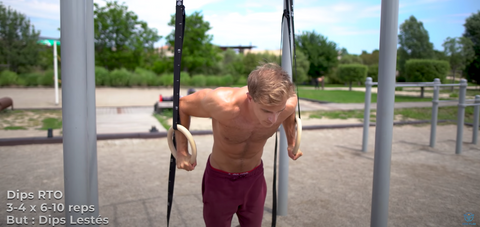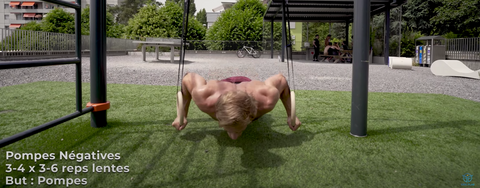Gymnastics Rings program and exercises!
Do you really need a lot of equipment to build muscle? I'm not sure.. Bodyweight exercises like Street Workout can help you reach your strength and muscle mass goals without expensive equipment. I'll show you how to avoid common mistakes and progress effectively.
In this article: 5 basic gymnastic ring exercises + 2 bonuses that will help you if you want to tackle more advanced figures.
Let's go ! 🔥
Exercise 1: Vertical Pull-Ups
Let's start with vertical pull-ups. If you can't do full ones yet, start with negative pull-ups: just do the downstroke, slowing it down as much as possible. Then block at the top before descending. This will strengthen you quickly and help you get your first pull!
Once you've got the hang of it, start your sets with your maximum number of full reps, then finish with negative reps. Vary your sessions by also training the rise of each repetition. You can also do assisted pull-ups with a rubber band or by keeping your feet on the ground to help you.





The big advantage of gymnastic rings is that you can easily adjust the suspension straps to the height you want.
Once the pull-ups become too easy, keep progressing with variations that use one arm more than the other, such as archer pull-ups. You can also weight yourself down if you have a bit of equipment.
If you need equipment like gymnastic rings, elastic bands, a weighted belt, or anything else, you'll find it all in my store. I've designed these products with the same high standards of quality as my videos and the rest of my work.
Exercise 2: Gymnastic Rings for Dips
For the second exercise, the aim is to achieve dips, but first you need to master active support on the Olympic rings. This step is essential to manage the unique instability of the rings.
The longer the straps, the more unstable the rings. Adjust them to hip height and start by holding on with your arms outstretched. If necessary, support yourself with the tips of your feet until you can hold on without shaking for 15 to 20 seconds.
Next, do some slow negatives to strengthen yourself before achieving your first dips. You can also do assisted dips with a rubber band or by keeping your feet on the ground, but use the latter as a last resort as it's difficult to measure your level of assistance exactly.



 An important note, especially if your aim is to progress towards Street Workout more advanced: you'll soon need to familiarize yourself with the RTO (Ring Turned Out). This involves turning the rings outwards, which complicates matters and puts more stress on your biceps.
An important note, especially if your aim is to progress towards Street Workout more advanced: you'll soon need to familiarize yourself with the RTO (Ring Turned Out). This involves turning the rings outwards, which complicates matters and puts more stress on your biceps.The best thing is to start working on active support again, but this time in RTO. Once you're comfortable with this position, you'll be able to tackle this version of the dips. This involves rapidly turning the rings outwards between each repetition.


And finally, once you've got the hang of it, the best way to continue to gain in force in muscle with dips as well as to progress in bodybuilding is to weigh yourself down more and more.

Exercise 3: Hanging Knee Lifts
The third exercise is the suspended knee lifts to work your abs, among other things. A good progression goal is to raise your knees higher and higher. To intensify the exercise, lock your knees for a second in the upright position to control the movement.

From there, to progress further, start to unfold your legs more and more. You can also do your deadlifts from the active support position, which is more difficult and will enable you to build all the foundations you need to learn to hold the L-sita very beautiful first figure.
Alternatively, before or after this, continue to raise your knee-ups even higher until you eventually tip backwards and learn to master the Skin the Cat. This complex exercise will be very useful for progressing to other figures later on.

Exercise 4: Horizontal pull-ups with Olympic rings
For the fourth year in a row horizontal tractionYou can conveniently vary the difficulty by adjusting the height of the rings. The more vertical you get, the easier the exercise becomes.
To progress further, you can either find a way to place your feet higher than your hands, or try the one-arm version, again adjusting the height of the rings to suit the difficulty.


Exercise 5: Pumps
For the fifth financial year pumpsThey are even more difficult on the Olympic rings. As with the dipsThe first step is to succeed in holding the active, standard and RTO support position firmly, which will also work on your sheathing.
To simplify the exercise, you can simply place the rings higher up.





If you're having trouble with ring pumpsyou can progress on the ground, which will transfer quite well. However, RTO is still very specific to rings.
Thereafter, as on the ground, raising the feet slightly and working on one-arm progressions will be excellent ways of increasing the difficulty.
Bonus Exercise 1: The False Grip at the Olympic Rings
We now move on to the first bonus exercise, which is important for the rings and necessary to achieve the famous muscle-up: the false grip. This is a way of catching the rings by resting and holding the top of the wrist on them.
To prevent it from slipping too low, use a little magnesia, it will help a lot.

You can therefore start to train your false grip at the end of the session, hanging as long as possible. This will be easier if you keep your arms bent, but ideally, you'll want to be able to hold on with your arms outstretched as well.
From here on in, if you want to work towards the muscle-up, replace the first exercise in the routine with false grip pull-ups. Once you've got a dozen or so in a row, you should be able to tackle the negative muscle-ups.
During the negative muscle-ups, try to keep the false grip from start to finish, slowing down the transition between dips and pull-ups as much as possible. With enough effort and time, you'll be able to perform your first muscle-up on the Olympic rings.
With this approach, you'll lay the foundations for many more successful muscle-ups in the future.




Bonus Exercise 2: The German Hang
The second bonus exercise you can do at the end of your session, or at the beginning to warm up, is the German Hang. It's an excellent exercise for shoulder mobility and strength. You'll already be familiar with this position when you train the Skin the Cat.
Maintaining this position will benefit your shoulders. This will lay a good foundation for progressing to more advanced figures, such as the Back Lever.
Gymnastics Rings Program/Routine

I advise you to make a note of your results so that you know what you did last time. This will motivate you to beat your records!
In my opinion, this is one of the best ways to make rapid progress, even if it may seem obvious.
If you liked this article, don't hesitate to comment on it 🔥
Thanks for reading, take care, see you soon! 💪
Eric Flag




Leave a comment
This site is protected by reCAPTCHA, and Google's Privacy Policy and Terms of Service apply.